Rando racing is growing in the U.S., even if California skiers have been a little slow to join the fray. With two upcoming races in the Sierra, that may be changing
By AJ Johnson
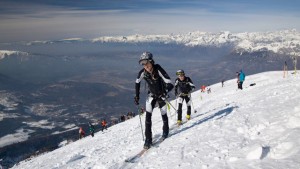
Backcountry skiing has been on a strong growth spurt as evidenced by the increasing number of vehicles at the trailheads and the booming interest in alpine touring (AT) gear. Most skiers just want to go out on day tours or to find that remote powder stash, but like most forms of recreation, there is also a form of competition —randonee racing.
Randonee — “rando” for short, or “ski mountaineering” if perhaps you’re a Francophobic politician — racers use lightweight ski gear to race up and down the mountain, pitting themselves not only against each other but against the terrain and the elements. The sport continues to grow in Europe, the birthplace of alpinism and ski mountaineering, and has gained prominence stateside in Colorado and the rest of the Rockies, but has yet to really establish a competitive presence in California.
However, two races this winter in the Sierra — in Mammoth Lakes (Feb. 25) and Bear Valley (March 24) — may help ignite interest among those that love both mountain challenges and competition. Both races are sanction by the U.S. Ski Mountaineering Association.
Rando racing is one of those few sports that combine aerobic fitness, dynamic movement, and individual reliance with an element of danger. Most races take place at a ski resort, where athletes follow a course up and down the mountain. Some events follow a simple course, while others go up and down several times. Racers need to put on and take off skins, modulate their body temperature, stay hydrated and, of course, stay upright. Snow conditions and the weather are a constant variable, so you have to be ready for anything.
Having done several races in Colorado, I can say that randonee racing gives you a thrill and sense of adventure that few events can match. Rather than being on a road surrounded by people, you’re on your own, facing a mountain. Your view is of grand peaks covered in snow, not mini-malls and office parks. The scale of the land and the constant threat of changing weather give you a feeling of true adventure, that you are part of something epic.
Survive a race and the sense of satisfaction at the end is pretty special. Unlike say running in a road race, rando racers can look back at the peaks they summited and say, “Yeah, I skied up and down that.”
____________________________________________________________________________
“I think the key is getting one of these off the ground. When it becomes a successful event, then other people replicate that, and then people collaborate and make a series out of these things.” —Aaron Johnson, Mountain Adventure Seminars, race director of the Bear Valley Adventure Ski Race
_____________________________________________________________________________
Despite these exciting elements and the proliferation of skiers using randonee-style touring gear — more frequently referred to as AT gear on this side of the pond — rando racing just hasn’t gained much traction among California’s snow community yet. The largest challenge may be a function of visibility — namely, the lack of it.
“My take on the situation is just that California skiers don’t know about (the sport),” says Aaron Johnson of Mountain Adventure Seminars in Bear Valley. “In its truest form, Californians don’t have any clue about it.”
Brendan Madigan, owner of Aplenglow Sports in Tahoe, believes randonee gets lost in the mix. “From a Tahoe perspective, there are many advanced skiers that are totally consumed by the terrain at places like Squaw and in the backcountry. Many people, on the flip side, are into nordic skiing, so (rando racing) kind of gets lost in the middle.”
Simply put, most just don’t have rando racing on their radar.
Another obstacle is the perception of the sport. Like many mountaineering sports, randonee is hugely popular in Europe, where top-of-the-line lightweight gear, lycra ski suits and serious competition are the norm.
But like Speedos at the beach, that image does not play so well in America, where such forms of alpinism are less ingrained in the culture, lycra doesn’t fit the dominant on-slope fashion style, and skiers tend to favor heavier AT gear and put much more emphasis on going down than up.
Plus, many see the sport as something only for “serious” or “extreme” athletes, not as something one can try just for the fun of it.
“For Americans, it has to be designed to be fun, having a theme kind of like a 10K fun run,” says Madigan.
While sales of backcountry skiing equipment have boomed over the last 10 years, this has not translated into the racing side yet. Data from the SnowSports Industries of America shows that just in the last two years AT boots rose 23 percent and AT bindings rose four percent in units sold, while AT skis actually dropped 15 percent.
Kelly Davis, director of research for SIA, believes those stats show that “not all AT boot and binding consumers are looking for the lighter weight type of ski that core AT participants might purchase. Much of the growth in sales in this category is about the side country (short hikes within or outside the boundaries of resorts).” For this reason most buyers opt for standard alpine skis.
So what will it take beyond snow on the ground to generate greater interest in rando racing in California?

As noted earlier, there will be two events this winter in the Sierra, the Mammoth Chase on Feb. 25, and the Bear Valley Adventure Ski Race on March 24 . The latter will be concurrent with the Bear Valley Telemark Festival (March 23-25) which was postponed from early February.
MAS’ Johnson helped with permits for the event in Bear Valley last year, and took over as the race director this year. He has a long-term vision for the event. “We’ll start small this year. My grand vision is to build a backcountry festival, and this race would be the centerpiece of a two or three-day event,” he says.
He believes the success of one event could lead to others and possibly even a series. “I think the key is getting one of these off the ground. When it becomes a successful event, then other people replicate that, and then people collaborate and make a series out of these things. Two to three years are what it’s going to take to get an event so that it’s viewed as successful.”
Another key to building the visibility of rando racing is changing the uphill policy of many of California’s resorts. Skinning at a resort is the easiest and safest way to get in shape for a rando race, while exposing other skiers to the sport. When skiers on a lift see someone skinning up, they may laugh or be intrigued, but either way at least they are now aware of the sport.
However, many resorts are so worried about the risks and potential lawsuits that uphill traffic is banned. Resorts in other states have opened up to skinning, but California still lags behind.
“The only two resorts (in California) that allow uphill travel are Sugar Bowl and Alpine Meadows,” says Madigan. “The rest of the resorts are quite antiquated in their policies regarding uphill travel. I think just like they’ve done in Colorado, and in Salt Lake at Brighton, where they let you skin, we’re kind of waiting for the resorts to catch on to the fact that, hey, you can make money by allowing these people to come to the resort for fitness.”
Tackling the perception that rando racing is only for the hardcore, Johnson is careful in presenting his event’s image. Rather than a race, he believes that Californians want something else. “They almost want it more for the sense of adventure. It’s, ‘Give me a challenge. Give me something that will kick my ass and then feed me some good food and beer, and I’ll have a great time,’” he says.
In his aim to make the event as inclusive as possible, he’s taking every detail into account. “I’ve considered changing the name of our event to the Bear Valley Adventure Ski Race (since done; it was formerly called the Bear Valley Randonee Series). You have the rules of no snowshoes, but who cares if they are on tele gear or AT gear or even if snowboarders using split boards have at it,” he says.
Only time will tell if the sport of randonee racing takes off in California. It won’t happen in one season, but as more people look for new and unique challenges, racing up and down mountains on skis is bound to give them a challenge and a thrill.
_____________________________________________________________________________
“The only two resorts (in California) that allow uphill travel are Sugar Bowl and Alpine Meadows. The rest of the resorts are quite antiquated in their policies regarding uphill travel.” —Brendan Madigan, Alpenglow Sports
______________________________________________________________________________
Johnson is optimistic. “Californians like to get out and race, do adventures and do challenges. I think randonee is growing; I think it’s here to stay. I can’t see it not growing if it’s well organized and well put together.”
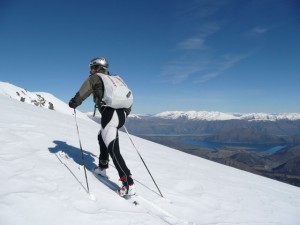
Perhaps it will even be commonplace to see competitors sporting lycra suits with their AT boots. Hey, competitive swimmers don’t wear board shorts after all!
Author AJ Johnson spent 11 years in Colorado, skiing as often as possible. He raced his first randonee race, a 24-hour event, as part of a four-man team using rented gear. He now lives in Ventura and edits an online triathlon magazine, a sport which was once thought of as strange and extreme, as well, and is quite familiar with lycra outfits, too.












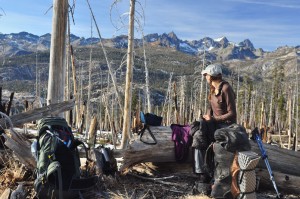
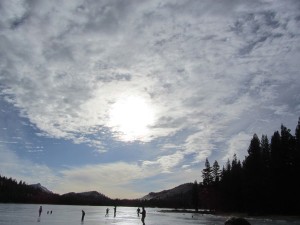
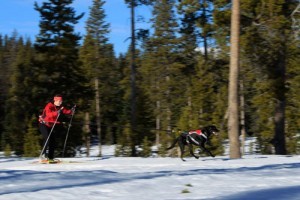
AJ,
Nice article. I hope the scene in California grows. Races here in Colorado are “booming”. (Relative term.) Lots of races. I’ve raced nine times already, with two more this weekend at the Teva Games. But the fields are still stacked and top-heavy with elites. Would be nice to see more participation by “regular” recreational athletes. It’s a blast, and just like triathlon, people tend to quickly be hooked by the combination of strenuous effort, exhilaration and setting – as you described so well.
Hope you are enjoying California.
Mike
Hey I live up in central cali near Fresno. Just got my first setup of rando gear. TLT5/vertical ST, although I got it more for general back-country use. I come from a triathlon and marathon background so I’d love to try rando racing! Do you know of any races happening in Cali this year?
Hi Andrew, Congrats on your new Rando Gear. Mountain Adventure Seminars will be having an Adventure Ski Race, which will include randonee, in Bear Valley in March. Give them a call at (209) 753-6556 or check them out at http://www.mtadventure.com. They may know of some other California races happening as well. Have a great season, enjoy!
There is a Randonee race happening in Nor Cal on Saturday feb 2 at the Mt Shasta ski park! The ski park sits on the flanks of mount shasta, it should be a fun race event. That evening is the 11th annual snow ball event as well, it’s a big party for outdoor enthusiasts in the area.
Thanks for this. Look forward to learning more. Post photos on our Facebook site and keep us posted next year so we can make sure to get this in our calendar. Have a great race!
Bear Valley Adventure Race Series is Jan. 31, 2015 • Feb. 28, 2015 • Mar. 28, 2015
This is a new series of “Freeheel” events where you can Randonee, Splitboard, or Telemark in California’s Bear Valley Resort. The final event in March features instruction, guided trips, experiential, and huge party on the final night!
Hi Mike, Feel free to post this event on our website at https://adventuresportsjournal.com/events-2/add-event. Keep us in mind for future listings in the print issue which has a greater reach.